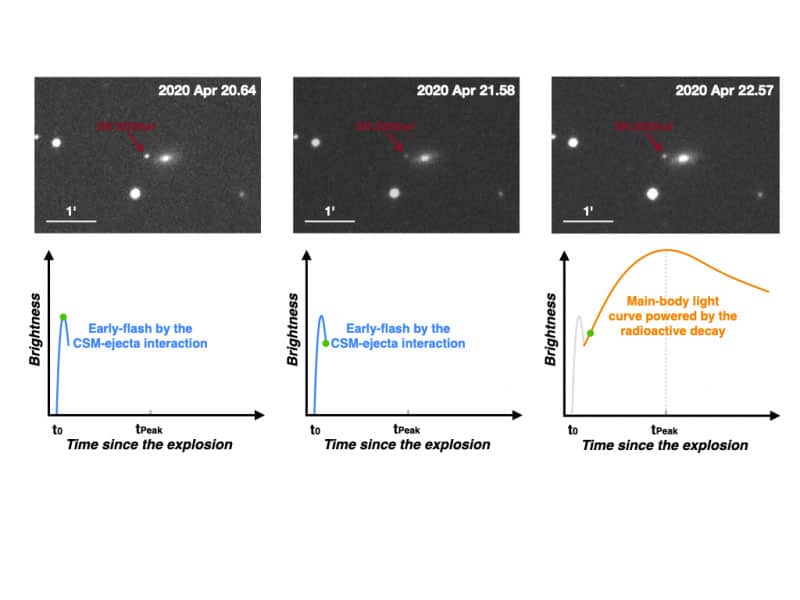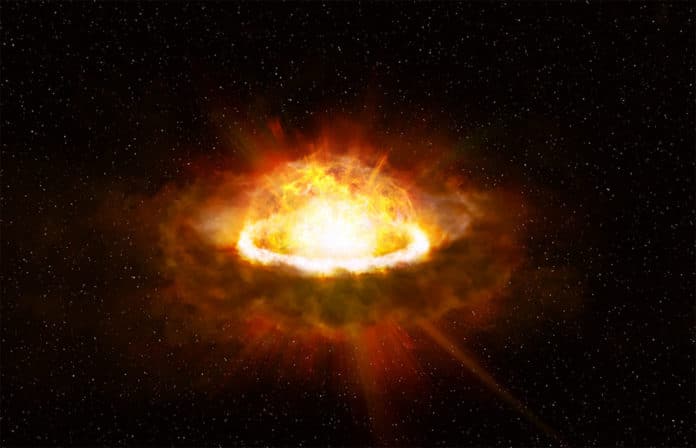Type Ia supernovae (SNIa) are thought to result from the explosion of a white dwarf in a binary system. Scientists often use Type Ia supernova as a standard candle for distance measurements in astronomy.
Despite the great success of the Type Ia supernova cosmology, scientists are still puzzled by basic questions such as what the progenitor systems of Type Ia supernovae are and how Type Ia supernova explosions are ignited.
To find out the solutions, a team of astronomers led by the Kavli Institute for the Physics and Mathematics of the Universe (Kavli IPMU) Project Researcher Ji-an Jiang attempted to catch Type Ia supernovae within one day of their explosions, called early-phase Type Ia supernovae named SN 2020hvf. Using new-generation wide-field survey facilities, including the Tomo-e Gozen camera, they discovered the fastest optical flash of a Type Ia supernova.
While regularly checking early-phase supernova candidates discovered by the Tomo-e transient survey, one transient called Tomo-e202004aaelb caught scientists’ attention.
The team discovered the transient ‘Tomo-e202004aaelb’ with high brightness on April 21 in 2020. In the next two days, significant variation was observed in its brightness. Later, it behaved like a typical early-phase Type Ia supernova.
Jiang said, “We have discovered several early-phase Type Ia supernovae that show interesting excess emission in the first few days of their explosions but have never seen such a fast and prominent early emission in optical wavelengths. Thanks to the high-cadence survey mode and the excellent performance of Tomo-e Gozen, we can perfectly catch this amazing feature for the first time. Such a quick early flash should originate from a different origin compared to previously discovered early-excess Type Ia supernovae.”

Computational simulations suggest that the origin of the mysterious fastest optical flash can be explained by the energy released from an interaction between supernova ejecta and a dense and confined circumstellar material (CSM) soon after the supernova explosion.
Kyoto University Associate Professor Keiichi Maeda said, “We have not seen such a short and bright flash from Type Ia supernovae before, even with a recently increasing number of very early discoveries soon after the supernova explosion in the last few years, including those discovered by our team. The nature of the CSM must reflect the nature of the progenitor star. This is a key to understanding what kind of a star explodes and how they do so. The question is, what makes this supernova so special.”
Kyoto University Project Researcher Miho Kawabata said, “At the first look of the spectrum taken just after the initial flash, it stood out as something different from normal supernovae. We noticed that the brightest class of Type Ia supernovae might look like this one if they were observed in such an early phase. Our classification was subsequently confirmed as the spectra evolve to look more and more similar to the previously found bright Type Ia supernovae.”
According to the team’s result, a dense CSM environment could have produced a fraction of Type Ia supernovae. Compared to typical Type Ia supernovae, the Tomo-e202004aaelb (SN 2020hvf) is brighter. Hence, the study provoked scientists to test various theories proposed for these peculiarities overluminous Type Ia supernovae.
Kavli IPMU Senior Scientist Ken’ichi Nomoto said, “Previously, we have constructed theoretical models of super-Chandrasekhar-mass rotating white dwarfs and their explosions. Such massive models can be consistent with the peak brightness of SN 2020hvf, but more theoretical work is necessary to explain the detailed observational properties. SN 2020hvf has provided a wonderful opportunity of collaboration between the theory and observations.”
Journal Reference:
- Ji-an Jiang, Keiichi Maeda et al. Discovery of the Fastest Early Optical Emission from Overluminous SN Ia 2020hvf: A Thermonuclear Explosion within a Dense Circumstellar Environment. DOI: 10.3847/2041-8213/ac375f
